Reindustrialization driving opportunities in Equities
Smokestacks. Lunch pails. Conveyor belts. We believe many still associate the manufacturing world with images such as these. And to be clear, a portion of the industrial base still bears these hallmarks. However, in the current era, in an economy we believe is experiencing a reindustrialization trend, we would cast the net a bit wider for consideration. Server racks. Clean rooms. Bioprocessing equipment. Robotics and controls. And electricity, lots of electricity.
To put some numbers around this issue, we would note that industrial capacity in the U.S. has declined nearly 8% from its 2008 peak. Yet, we would also note that U.S. manufacturing capacity has expanded modestly in each of the past three years, and we expect this phenomenon to extend into 2026 and likely beyond.3 It is important to note that we believe this is occurring as a result of a number of simultaneous cyclical and secular drivers. These include government policy, artificial intelligence (AI), and the hardening of supply chains.
Chart 1. U.S. manufacturing capacity from 1948 – 2024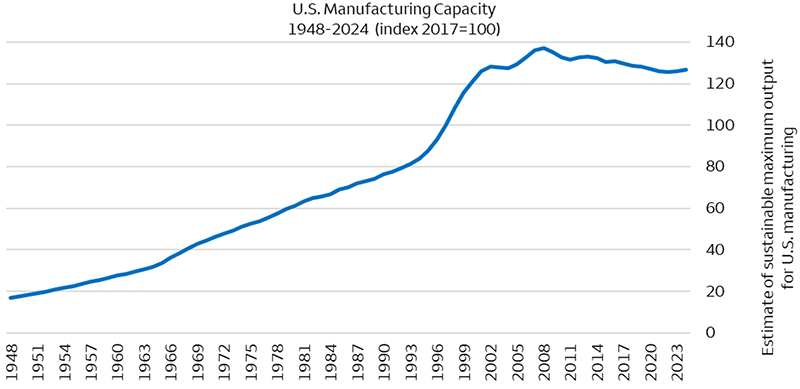
Sources: Federal Reserve and Wells Fargo Investment Institute. Annual data covering 1948-2024, with the data series last updated in September 2025.
In our view, shifting global trade patterns and the pandemic jump-started this story. Supply-chain vulnerabilities in semiconductors, health care, key industrial inputs, and certain commodities became clear against the backdrop of a more volatile operating environment. The increased prevalence of targeted government incentives for investment in domestic manufacturing in the areas noted above soon followed. Then, the AI infrastructure wave swung into full force. This was followed rapidly by both carrots and sticks from the U.S. government — more favorable tax and regulatory policy on the one hand, more tariffs and tighter trade restrictions on the other.
We believe these trends are durable and, as illustrated in Chart 1, many are overlapping. How significant could this be? Here, we would highlight projections from a leading electrical equipment and automation company, which recently outlined expectations for high-single to double-digit compounded annual revenue growth from the North American (primarily U.S.) end market for its operations over the 2025-2030 period.4 For reference, that is more than double the growth rate for nominal economic growth expected by the Congressional Budget Office over the same time frame.5
Chart 2. Selected cumulative end-market industry growth estimates from 2024 – 2030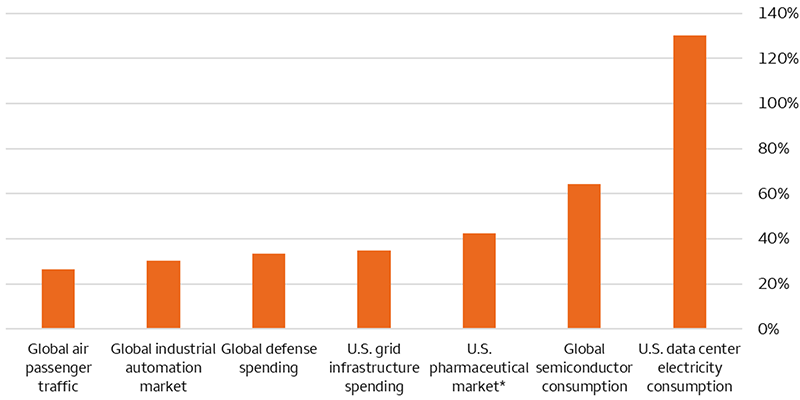
Sources: International Civil Aviation Organization (Global air passenger traffic), Schneider Electric (Global industrial automation market), Bloomberg (Global defense spending), TE Connectivity (U.S. grid infrastructure spending), McKesson (U.S. pharmaceutical market), PwC (Global semiconductor consumption), and International Energy Agency (U.S. data center electricity consumption). *Note: U.S. pharmaceutical market data covers the period 2024-2029.
We expect the strongest investment to be in data centers, semiconductors, life sciences, aerospace and defense, and power generation. We see this growth as driven both by underlying technological and societal trends. These trends in turn intersect with and contribute to an evolving supply-chain outlook.
In a recent survey, consultancy PwC found that 34% of surveyed executives expect 51% or more of their production to be reshored or nearshored by 2030.6 We note this dynamic as well because we believe investors need to think more broadly than the concept of reshoring smokestack industries and toward the view of reindustrialization in the themes seen in Chart 2. Companies that provide or employ inputs to these end markets span the Industrials, Information Technology, Health Care, Utilities, Materials, and Energy sectors, with parts of the Financials sector also acting as a key facilitator.
Although we believe that our favored sectors — Financials, Industrials, and Utilities — likely stand to benefit from these expected trends, perhaps more importantly, we would note that we believe a strong capital formation cycle is a constructive backdrop for the overall earnings power of U.S. equities.
3 Bureau of Economic Analysis via St. Louis Federal Reserve Database. Data as of September 2025.
4 Schneider Electric SE and Capital Markets Day, December 11, 2025. Please note that this is an illustrative estimate for end market growth rates and not intended to be a WFII projection for single company.
5 CBO: Long-Term Budget Outlook: 2025-2055, March 2025.
6 PwC: The future of energy and manufacturing, September 17, 2025.
Decoding the yield curve’s signals
The first two weeks of December have been filled with developments that influenced fixed-income yields. Comments from Federal Reserve (Fed) Chair Jerome Powell on December 10 reinforced the Fed’s view that downside risks to the labor market have increased. We believe the jobs report for October and November, which published on December 16, confirmed the job market’s fragility. Chart 3 shows that the U.S. Treasury yield curve steepened aggressively throughout 2025. The difference between 2-year and 30-year Treasury yields increased from 53 basis points (bps; 100 bps equal 1.00%) to over 132 bps. We expect the yield curve to steepen further in 2026.
Chart 3. Steepness of the U.S. Treasury yield curve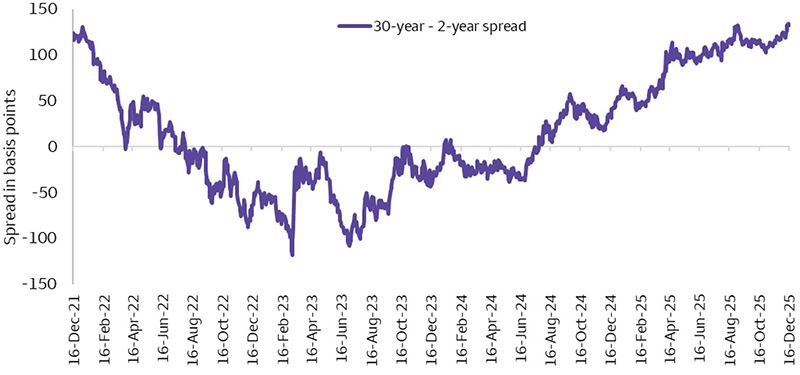
Sources: Bloomberg and Wells Fargo Investment Institute as of December 16, 2025. 30-year – 2-year spread is represented by the difference in yields of the 30-year U.S. Treasury bond and 2-year U.S. Treasury note.
Past performance is no guarantee of future results.
Is there a message embedded in the shape and steepness of the U.S. Treasury yield curve? In our view, there is. However, much has to do with the reasons causing the steepening. Is it because short-term yields have been falling, long-term yields have been rising or a combination of both? In the past two weeks, market expectations of Fed rate cuts have been volatile, but as of December 16th perceived market expectations for two rate cuts in 2026 match our own forecasts. This has pushed short-term U.S. Treasury yields lower while an anticipated economic rebound and potential for rising inflationary pressures have pushed long-term yields higher. Furthermore, term risk premium has been rising since late October. Given the indication from the U.S. Treasury of further issuance in 2026 coupled with better economic growth prospects, fixed income investors may continue to demand a higher term premium to remain invested in bonds in lieu of other investment opportunities.
The steepening of the yield curve impacts opportunities in the fixed-income markets. We remain unfavorable on both Short and Long Term Taxable Fixed Income. We believe investors are better rewarded in the intermediate portion of the curve (maturities between three and seven years), which may offer more attractive income opportunities with less interest-rate risk.
Venezuela’s oil — is it a concern?
Earlier this month the U.S. seized a Venezuelan oil tanker, sparking concerns of potential supply disruptions. Despite the escalation in geopolitical tensions, prices were largely unchanged with West Texas Intermediate crude oil trading at $55 per barrel as of December 16, 2025.
While escalating geopolitical tensions tied to crude oil supply have historically led to heightened volatility and near-term prices, we believe this time the effect could be different and crude oil prices are likely to remain rangebound in the near term for the following reasons:
- The global impact from disruptions in Venezuelan oil supply is limited due to low volumes. For years, Venezuela’s crude oil production has been hampered by sanctions and underinvestment. Since peaking in the 1970s, Venezuela’s crude oil production has deteriorated 74% to 960,000 barrels per day in 2025. Exports have shown a similar pattern, declining to roughly 549,000 barrels per day in 2025, or less than 1% of global consumption.
- Excess global supply stemming from OPEC+’s unwinding production cuts is a strong headwind for higher global prices. Additionally, the group’s planned pause in supply growth in early 2026 leaves ample spare capacity — mostly from Saudi Arabia — readily available to fill the supply gap in the case of a disruption. For now, we believe global oil markets are well supplied.
Overall, we do not believe recent events around Venezuela’s crude oil exports present a major risk of a spike higher in global crude oil prices. We maintain our neutral rating on the Commodity Energy sector and expect performance to be limited in the near term from oversupply conditions before rising modestly in 2026 amid a reacceleration of economic growth.
Chart 4. Venezuela’s long-term deterioration in crude oil production and exports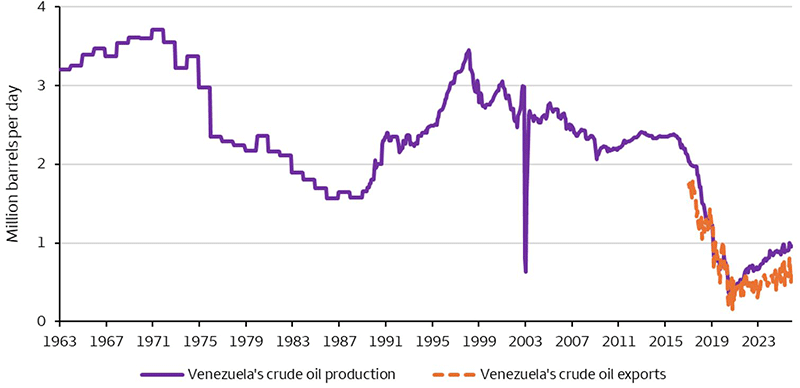
Sources: Bloomberg and Wells Fargo Investment Institute. Monthly data is from January 1963 – November 2025. Export data is from January 2017 – November 2025.
Manager selection drives private-market success
Private-market strategies differ significantly from public markets, often displaying a much wider dispersion of returns across funds. This means performance can vary dramatically from one manager to another. We believe identifying managers with distinctive sourcing capabilities and deep experience in evaluating and investing in compelling opportunities is a key factor in achieving positive results over time. Often, top-tier managers may hold competitive advantages that grant them access to highly sought-after deals. These advantages may include an extensive network of industry relationships, specialized expertise in specific market segments, and a disciplined approach to underwriting and pricing investments across market cycles.
Consider the performance gaps in the chart. Each bar in Chart 5 illustrates the range of performance amongst a group of managers in each of seven types of sub-strategies as named along the horizontal axis. Each bar also shows the internal rate of return (IRR) thresholds for the top and bottom deciles, as well as the median IRR for each category, as reported by Pitchbook. For instance, in the Venture Capital sub-strategy, the top decile of funds achieved an IRR of 31.7%, while the bottom decile posted an IRR of -7.0%. The other strategies show performance gaps of varying but significant size. These gaps (nearly 39% in the case of Venture Capital) underscore the critical importance of manager selection in private-market investing.
We conduct rigorous research and due diligence to improve the likelihood of selecting managers who rank near the top of their respective peer groups. This experienced team works to provide investors with access to managers it believes are the most talented and respected across the private-capital spectrum.
Chart 5. Private fund net IRR dispersion by strategy (vintage 2002-2019)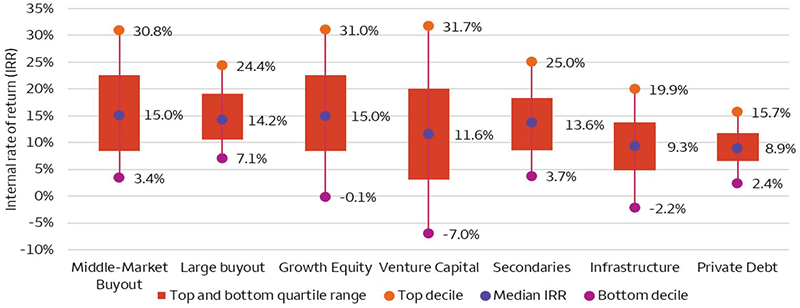
Source: Pitchbook. Q3 2025 US Market Insights report. Data as of December 31, 2024.
Definitions: The IRRs are measured for funds with vintages between 2002-2019. In general, a fund’s vintage year is defined as the year the fund was formed or began investing capital. Middle-Market Buyout, Large Buyout, Growth Equity, Venture Capital, Secondaries, Infrastructure and Private Debt categories as defined by Pitchbook. See index descriptions on pages 8-9. Decile is 10% of a population or peer group. Quartile is 25% of a population or peer group. Past performance is not a guarantee of future performance.
Alternative investments, such as hedge funds, private equity, private debt and private real estate funds are not appropriate for all investors and are only open to “accredited” or “qualified” investors within the meaning of U.S. securities laws.
7 Internal rate of return (IRR): The IRR is a method of calculating an investment rate of return. It highlights the compounded annual percentage return an investment yields over its life, with a higher IRR generally signaling a more desirable investment.
Cash Alternatives and Fixed Income
intentionally blank
intentionally blank
intentionally blank
| Most Unfavorable |
Unfavorable |
Neutral |
Favorable |
Most Favorable |
|
intentionally blank
|
- U.S. Long Term Taxable Fixed Income
- U.S. Short Term Taxable Fixed Income
|
- Cash Alternatives
- Developed Market Ex-U.S. Fixed Income
- Emerging Market Fixed Income
- High Yield Taxable Fixed Income
|
- U.S. Intermediate Term Taxable Fixed Income
|
intentionally blank
|
Equities
| Most Unfavorable |
Unfavorable |
Neutral |
Favorable |
Most Favorable |
|
intentionally blank
|
|
- Developed Market Ex-U.S. Equities
- Emerging Market Equities
|
- U.S. Large Cap Equities
- U.S. Mid Cap Equities
|
intentionally blank
|
Real Assets
| Most Unfavorable |
Unfavorable |
Neutral |
Favorable |
Most Favorable |
|
intentionally blank
|
intentionally blank
|
- Commodities
- Private Real Estate
|
|
intentionally blank
|
Alternative Investments**
| Most Unfavorable |
Unfavorable |
Neutral |
Favorable |
Most Favorable |
|
intentionally blank
|
intentionally blank
|
- Hedge Funds—Equity Hedge
- Hedge Funds—Macro
- Hedge Funds—Relative Value
- Private Equity
- Private Debt
|
|
intentionally blank
|
Source: Wells Fargo Investment Institute, December 22, 2025.
*Tactical horizon is 6-18 months
**Alternative investments are not appropriate for all investors. They are speculative and involve a high degree of risk that is appropriate only for those investors who have the financial sophistication and expertise to evaluate the merits and risks of an investment in a fund and for which the fund does not represent a complete investment program. Please see end of report for important definitions and disclosures.



 Sources: Federal Reserve and Wells Fargo Investment Institute. Annual data covering 1948-2024, with the data series last updated in September 2025.
Sources: Federal Reserve and Wells Fargo Investment Institute. Annual data covering 1948-2024, with the data series last updated in September 2025. Sources: International Civil Aviation Organization (Global air passenger traffic), Schneider Electric (Global industrial automation market), Bloomberg (Global defense spending), TE Connectivity (U.S. grid infrastructure spending), McKesson (U.S. pharmaceutical market), PwC (Global semiconductor consumption), and International Energy Agency (U.S. data center electricity consumption). *Note: U.S. pharmaceutical market data covers the period 2024-2029.
Sources: International Civil Aviation Organization (Global air passenger traffic), Schneider Electric (Global industrial automation market), Bloomberg (Global defense spending), TE Connectivity (U.S. grid infrastructure spending), McKesson (U.S. pharmaceutical market), PwC (Global semiconductor consumption), and International Energy Agency (U.S. data center electricity consumption). *Note: U.S. pharmaceutical market data covers the period 2024-2029. Sources: Bloomberg and Wells Fargo Investment Institute as of December 16, 2025. 30-year – 2-year spread is represented by the difference in yields of the 30-year U.S. Treasury bond and 2-year U.S. Treasury note. Past performance is no guarantee of future results.
Sources: Bloomberg and Wells Fargo Investment Institute as of December 16, 2025. 30-year – 2-year spread is represented by the difference in yields of the 30-year U.S. Treasury bond and 2-year U.S. Treasury note. Past performance is no guarantee of future results. Sources: Bloomberg and Wells Fargo Investment Institute. Monthly data is from January 1963 – November 2025. Export data is from January 2017 – November 2025.
Sources: Bloomberg and Wells Fargo Investment Institute. Monthly data is from January 1963 – November 2025. Export data is from January 2017 – November 2025.  Source: Pitchbook. Q3 2025 US Market Insights report. Data as of December 31, 2024.
Source: Pitchbook. Q3 2025 US Market Insights report. Data as of December 31, 2024.